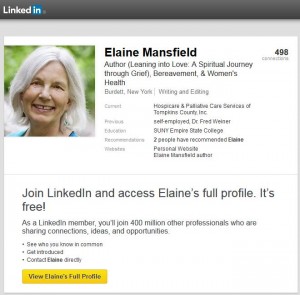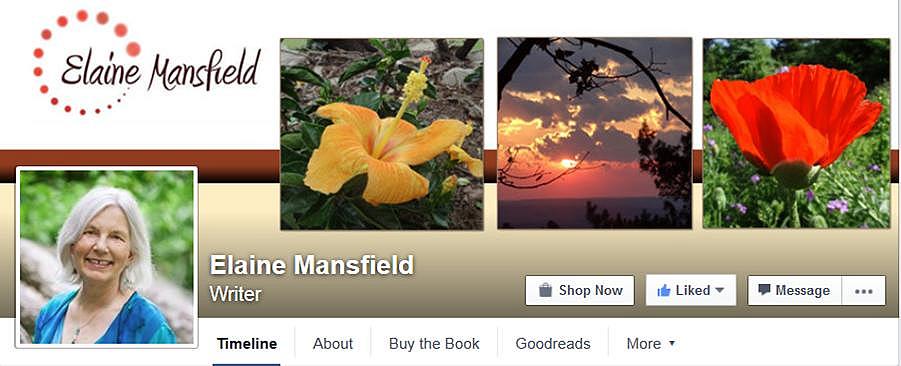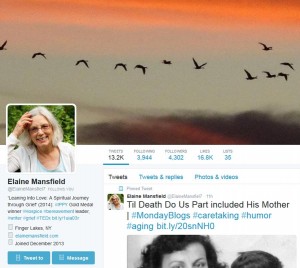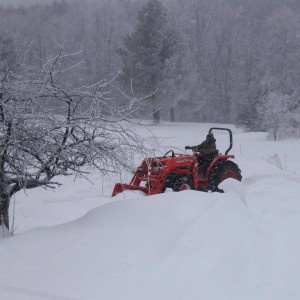
Elaine Mansfield is the author of Leaning Into Love: A Spiritual Journey Through Grief (Larson, 2014). Gold Medal Winner of the Independent Publisher Book Award 2015, her memoir captures your heart—from the extraordinary closeness of Elaine’s marriage to how she and Vic transformed their struggle with cancer and despair into a conscious relationship with mortality. After Vic’s death, Elaine leaned into her ongoing love as grief led her through overwhelming emotional and spiritual depths on a journey beyond their time together into her new life.
Working closely with Elaine Mansfield during the past several years I observed her as a writer who pulled others to her words using social media. When I review her social media metrics over two years it tells a powerful story about how a book found its audience. More than a year after her book’s release, Elaine’s blogs continue to be routinely shared several hundred times on Facebook, Twitter, and LinkedIn. She has more than 1,000 Friends on Facebook, 4,000 followers on Twitter, and 500+ on LinkedIn. And she has engaged with most of them in conversations about the topic of death. When I hear from aspiring authors they have no interest or intention in building an audience platform online I want to introduce them to Elaine and let them hear her story of finding readers.
Jill: You have a following and community of readers with whom you engage on Facebook, Twitter, LinkedIn and Google + that is the envy of many aspiring authors. I know from working with you over the past few years you built your audience platform organically. Please explain how you did it.
 Elaine: LinkedIn was a good way to connect with people who work in my area of interest that best matches my book—grief, bereavement, end-of-life, and hospice. A woman who has a strong online presence in bereavement encouraged me to join the Association of Death Education and Counseling so I could take part in LinkedIn groups limited to ADEC members, so I connected with many who were interested in what I was writing. I read and discussed their articles and often left comments on their blogs. I shared my blogs and book information. Some of my earliest contacts continue to be mutually supportive.
Elaine: LinkedIn was a good way to connect with people who work in my area of interest that best matches my book—grief, bereavement, end-of-life, and hospice. A woman who has a strong online presence in bereavement encouraged me to join the Association of Death Education and Counseling so I could take part in LinkedIn groups limited to ADEC members, so I connected with many who were interested in what I was writing. I read and discussed their articles and often left comments on their blogs. I shared my blogs and book information. Some of my earliest contacts continue to be mutually supportive.
One friendly connection leads to another connection on social media and sometimes a new opportunity such as an interview or writing a chapter for an anthology or submitting an article to a new journal. The constant exchange helps me stay current in my field and helps me find good articles to share.
 I enjoyed the social aspects of Facebook. Swenson Book Development nudged me to create an author page. I resisted. SBD was right. My Facebook page is a great place to present what matters to me. I post articles of interest to those who grieve or work in bereavement or hospice. I share my blogs, interviews, reviews, announcements, and articles. I share information about my book, but not too much. I post an inspiring quote or poem every day. My personal nature photos are popular on my Facebook page, so I post one each day.
I enjoyed the social aspects of Facebook. Swenson Book Development nudged me to create an author page. I resisted. SBD was right. My Facebook page is a great place to present what matters to me. I post articles of interest to those who grieve or work in bereavement or hospice. I share my blogs, interviews, reviews, announcements, and articles. I share information about my book, but not too much. I post an inspiring quote or poem every day. My personal nature photos are popular on my Facebook page, so I post one each day.
 Then—because I was encouraged by the team at Swenson Book Development—I tried Twitter. I was reluctant to spend more time on social media. But it didn’t take much time and was easy to learn. I was surprised to see how many connections were made sharing events and information about my book, Leaning into Love: A Spiritual Journey through Grief, and through my TEDx talk, “Good Grief! What I Learned from Loss.” I’m now writing about mythology and Jungian Psychology and Twitter has helped me connect with others interested in these topics.
Then—because I was encouraged by the team at Swenson Book Development—I tried Twitter. I was reluctant to spend more time on social media. But it didn’t take much time and was easy to learn. I was surprised to see how many connections were made sharing events and information about my book, Leaning into Love: A Spiritual Journey through Grief, and through my TEDx talk, “Good Grief! What I Learned from Loss.” I’m now writing about mythology and Jungian Psychology and Twitter has helped me connect with others interested in these topics.
I experimented with Pinterest and Google+. Facebook, Twitter, and LinkedIn take time when I follow up on comments and read what others share. Trying to participate in every social media platforms doesn’t leave enough time to write and live. Social media can be a time eater, so I limit my time and take Saturdays and most of Sundays off.
Jill: Could you share with readers some tips on cultivating relationships with readers and what that means to you as an author?
Elaine: The key is interaction which means commenting, reading, and sharing articles written by others. If someone shares something I’ve posted, I return the favor. Yes, it takes time, but it’s a way to build connections that matter. When I look at a Facebook or Twitter page where the writer shares only his own pieces and sales promotions, I soon move on. Social media includes promotion, but has to be social and interactive to be effective.
 Learn to use hashtags. If you don’t understand, do a Google search. You’ll be glad you did, because hashtags make your social media time productive. For example, I might post a blog I’ve written and add #grief and #healing to the description. If another person searches either of those words, they’ll find my post and connect with me. There are “hashtags” for writers such as #amwriting. There are hashtags for sharing opportunities such as #MondayBlogs and #linkyourlife. There are hashtags for various interests such as psychology, health, politics, or parenting. Use hashtags and you’ll get more social media action in less time.
Learn to use hashtags. If you don’t understand, do a Google search. You’ll be glad you did, because hashtags make your social media time productive. For example, I might post a blog I’ve written and add #grief and #healing to the description. If another person searches either of those words, they’ll find my post and connect with me. There are “hashtags” for writers such as #amwriting. There are hashtags for sharing opportunities such as #MondayBlogs and #linkyourlife. There are hashtags for various interests such as psychology, health, politics, or parenting. Use hashtags and you’ll get more social media action in less time.
Make social media fun. Do something adventurous. Share something just because you find it beautiful or silly. Experiment and enjoy the interaction. Your enthusiasm will interest others in your work.
Jill: As I recall, you initially expressed some reluctance to using social media as an author. This is a fairly common reaction. What were some of the pleasant surprises you experienced from using social media as an author?
Elaine: Initially, I whined and dragged my feet. I felt overwhelmed with the work of being a writer and preparing a book for publication. Even though you told me, I didn’t fully appreciate how helpful and necessary it would become to find people who share my interests. There are so many books out there. Those new good books are competing with your new good book. Part of finding an audience for an unknown writer is good luck, but much of it depends on the hard work of looking for and connecting to like-minded people.
I could have focused more energy on building relationships while finishing my book. I’m glad I did as much as I did. Building a social media platform and writing are different sorts of work. Authors must do both. Sometimes I need a break from editing or writing as I wait for the right idea. Those times are made for social media. Build your connections, build your platform, read what others are writing, learn more about use of hashtags, or explore Pinterest to see if it appeals to you.
I have significant hearing loss, so communicating online is particularly satisfying for me. I imagine people with mobility problems would feel the same. I also live in a place where winter travel can be daunting, so it’s nice to connect with a friend on Facebook on a cold dark night.
Jill: And what advice would you give to someone who wants to publish but resists the requirement of building an online presence?
 Elaine: Stick your toe in the water. Or take a plunge. I learned a huge amount from coaching sessions with Swenson Book Development. A google search brings up articles with advice about which social media platform is best for your area of interest. Be willing to experiment, persist a while, and drop what doesn’t work. I’m surprised that sharing photos from my daily life is a hit on my Facebook author page, but it is. Nothing healed my broken heart as much as being in nature. I think we do well when we share what moves, inspires, or informs us.
Elaine: Stick your toe in the water. Or take a plunge. I learned a huge amount from coaching sessions with Swenson Book Development. A google search brings up articles with advice about which social media platform is best for your area of interest. Be willing to experiment, persist a while, and drop what doesn’t work. I’m surprised that sharing photos from my daily life is a hit on my Facebook author page, but it is. Nothing healed my broken heart as much as being in nature. I think we do well when we share what moves, inspires, or informs us.
If you’re an unknown writer and don’t have a large platform in another media area such as film or music, it’s hard to imagine doing well without building an online presence. My social media work began with a beautiful and informative website. Experiment with social media options and think of time spent as part of your work schedule. See where it takes you.
Thank you, Elaine Mansfield, for your honesty and generosity in sharing your perspective on using social media as an author.
If you need help building your audience platform, contact Jill

I’m very grateful for the advice about building platform that I also originally dragged my feet about. Twitter and Facebook have actually become an important parts of my day. Social media became especially meaningful to me as I discovered grief groups and the thousands of others out there who are in various stages of dealing with similar significant loss.
Getting past your resistance is often the biggest hurdle. You jumped it and dove in head first. Now you’re swimming effortlessly! And I see your posts make a bigger splash than ever.
Elaine was a bit of a model for me when I first plunged into social media. I can only salute her point about making social media fun. If you’re having fun, your contacts will notice it and be drawn to you.
Thanks Ann for your comment. Elaine is a great role model for using social media as an author and you’ve learned lessons to make your own efforts in this regard succeed. Having your posts go viral is a wonderful reward.
Elaine is a wonderful role model for me as an emerging writer. She is always up for something new. She has developed her own, authentic style. That is her charm. And you are the Captain of her cheerleading squad Jill. Lucky Elaine!